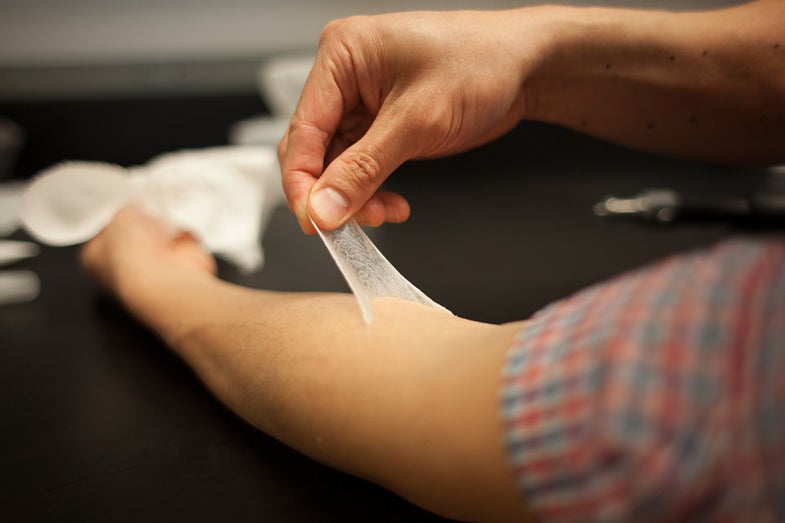A Removable ‘Second Skin’ Could Cover Your Real One
To reduce wrinkles and treat skin conditions


It’s hard not to envy the softness and healthy glow of a baby’s skin. As we grow, freckles, wrinkles, and age spots begin to take hold–an aging process that seems inevitable and irreversible. But maybe not, according to a group of researchers who have created a silicone membrane that nearly invisibly adheres to the skin to eliminate wrinkles and under-eye bags, apply sunscreen, and even treat eczema and other skin conditions. Their work was published today in the journal Nature Materials.
Younger skin has more collagen, a type of protein that holds skin together. As we age, we lose a certain amount of that collagen each year, which makes our skin less elastic and more prone to wrinkles and bags. The material, called Second Skin, is made up of siloxanes, which together form polymers, or molecules that are made of long chains of repeating units. This material, which is extremely thin and nearly invisible, mimics those properties of younger skin. To apply it, first a clear liquid is applied to the skin, then the Second Skin is applied, which adheres to the liquid polymer and links its molecular chains together, making it stronger. The skin stays on for a least a day, but can be washed off at any point using a solution that can dissolve the polymer material.
With this basic idea, Second Skin can be used in a variety of different ways. To help with wrinkles, applying the material could help increase the elasticity of the skin and tighten the wrinkles, both during and for a few hours after being worn. It can be worn all day as an invisible layer, helping to reduce wrinkles throughout the day. The material can be presoaked in sunscreen to protect skin from the sun without the fear of it washing off from water or sweat.
It can also be used to treat eczema or psoriasis by applying medication or moisturizers directly to Second Skin and having that sit on a person’s skin for an extended period of time. Currently many skin treatments rely on creams being applied to the skin, but those creams are rubbed or washed off easily.

Research needs to be done to determine how exactly it should be used to treat aging skin, and how easily people will be able to apply it to their own skin. In the study, the researchers tested the product to see how well it held up against exposure to elements like water, sun, and sweat, and if it could make a visible difference for treating bags under the eyes. They found that it stayed on regardless. During a controlled study in which half of the participants were assigned to use Second Skin and the other half a placebo, people were trained to observe and grade the skin on how visible the under-eye bags were.
These tests were all meant as a proof of concept, to see if it could actually work. As New Scientist points out, if Second Skin were to ever be sold commercially as a cosmetic product, it would need to go through the FDA to ensure the polymer itself doesn’t cause any harm. Then if it were to ever be sold as a medical product, it would need to go through controlled studies that show its effective.
The product was funded by a biotech company called Living Proof, and is being developed by a company called Olivo Laboratories, in which the authors of the paper have an equity interest.
